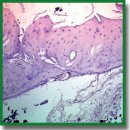
Biocompatibility and Osseointegration of Calcium Phosphate-Coated and Non-Coated Titanium Implants with Various Porosities
The aim of the investigation was to study the influence of pore size and the presence of a biologically active calcium phosphate coating in porous 3D printed titanium implants on the process of integration with the bone tissue.
Materials and Methods. Samples of cylindrical implants with three different pore diameters (100, 200, and 400 μm) were fabricated from titanium powder on the Arcam 3D printer (Sweden) using electron beam melting technology. A calcium phosphate coating with a thickness of 20±4 μm was applied to some of the products by microarc oxidation. Cytotoxicity of the implants was determined in vitro on human dermal fibroblast cultures. The samples were implanted in the femoral bones of 36 rabbits in vivo. The animals were divided into 6 groups according to the bone implant samples. The prepared samples and peri-implant tissues were studied on days 90 and 180 after implantation using scanning electron microscopy and histological methods.
Results. All samples under study were found to be non-toxic and well biocompatible with the bone tissue. There were revealed no differences between coated and non-coated implants of 100 and 200 μm pore diameters in terms of their histological structure, intensity of vascularization in the early stages, and bone formation in the later stages. Samples with pore diameters of 100 and 200 μm were easily removed from the bone tissue, the depth of bone growth into the pores of the implant was lower than in the samples with pore diameter of 400 μm (p<0.001). There were differences between coated and non-coated samples of 400 μm pore diameter, which was expressed in a more intensive osseointegration of samples with calcium phosphate coating (p<0.05).
Conclusion. The optimal surface characteristics of the material for repairing bone defects are a pore diameter of 400 μm and the presence of a calcium phosphate coating.
- Eltorai A.E.M., Nguyen E., Daniels A.H. Three-dimensional printing in orthopedic surgery. Orthopedics 2015; 38(11): 684–687, https://doi.org/10.3928/01477447-20151016-05.
- Rosenberg O.A., Sheikin S.E., Sochan S.V. Prospects for the using of technically pure titanium for implants in bone surgery. NMT 2010; (2): 50–54.
- Bondarenko S., Dedukh N., Filipenko V., Akonjom M., Badnaoui A.A., Schwarzkopf R. Comparative analysis of osseointegration in various types of acetabular implant materials. Hip Int 2018; 28(6): 622–628, https://doi.org/10.1177/1120700018759314.
- Korytkin A.A., Zakharova D.V., Novikova Ya.S., Gorbatov R.O., Kovaldov K.A., El Moudni Y.M. Custom triflange acetabular components in revision hip replacement (experience review). Travmatologiya i ortopediya Rossii 2017; 23(4): 101–111, https://doi.org/10.21823/2311-2905-2017-23-4-101-111.
- Tikhilov R.M., Shubnyakov I.I., Denisov A.O., Konev V.A., Gofman I.V., Mikhailova P.M., Netylko G.I., Vasiliev A.V., Anisimova L.O., Bilyk S.S. Bone and soft tissues integration in porous titanium implants (experimental research). Travmatologiya i ortopediya Rossii 2018; 24(2): 95–107, https://doi.org/10.21823/2311-2905-2018-24-2-95-107.
- Qadir M., Li Y., Munir K., Wen C. Calcium phosphate-based composite coating by micro-arc oxidation (MAO) for biomedical application: a review. Crit Rev Solid State 2018; 43(5): 392–416, https://doi.org/10.1080/10408436.2017.1358148.
- Dubrov V.E., Klimashina E.S., Shcherbakov I.M., Shipunov G.A., Putlyaev V.I., Evdokimov P.V., Tikhonov A.A., Zyuzin D.A., Danilova N.V., Mal’kov P.G. Experimental evaluation of the properties of 3D porous bone substitute based on calcium phosphate on the model of monocortical diaphysial femur defect in rats. Bull Exp Biol Med 2019; 167(3): 400–403, https://doi.org/10.1007/s10517-019-04536-7.
- Bolbasov E.N., Popkov D.A., Kononovich N.A., Gorbach E.N., Khlusov I.A., Golovkin A.S., Stankevich K.S., Ignatov V.P., Bouznik V.M., Anissimov Y.G., Tverdokhlebov S.I., Popkov A.V. Flexible intramedullary nails for limb lengthening: a comprehensive comparative study of three nails types. Biomed Mater 2019; 14(2): 025005, https://doi.org/10.1088/1748-605x/aaf60c.
- Popkov A.V., Popkov D.A., Kononovich N.A., Gorbach E.N., Tverdokhlebov S.I., Bolbasov E.N., Darvin E.O. Biological activity of the implant for internal fixation. J Tissue Eng Regen Med 2018; 12(12): 2248–2255, https://doi.org/10.1002/term.2756.
- Albrektsson T., Johansson C. Osteoinduction, osteoconduction and osseointegration. Eur Spine J 2001; 10: S96–S101, https://doi.org/10.1007/s005860100282.
- Gittens R.A., Olivares-Navarrete R., Schwartz Z., Boyan B.D. Implant osseointegration and the role of microroughness and nanostructures: lessons for spine implants. Acta Biomater 2014; 10(8): 3363–3371, https://doi.org/10.1016/j.actbio.2014.03.037.
- Hayes J.S., Klöppel H., Wieling R., Sprecher C.M., Richards R.G. Influence of steel implant surface microtopography on soft and hard tissue integration. J Biomed Mater Res B Appl Biomater 2017; 106(2): 705–715, https://doi.org/10.1002/jbm.b.33878.
- Tavakoli J., Khosroshahi M.E. Surface morphology characterization of laser-induced titanium implants: lesson to enhance osseointegration process. Biomed Eng Lett 2018; 8(3): 249–257, https://doi.org/10.1007/s13534-018-0063-6.
- Kalinichenko S.G., Matveeva N.Y., Kostiv R.Y., Edranov S.S. The topography and proliferative activity of cells immunoreactive to various growth factors in rat femoral bone tissues after experimental fracture and implantation of titanium implants with bioactive biodegradable coatings. Biomed Mater Eng 2019; 30(1): 85–95, https://doi.org/10.3233/bme-181035.
- Ran Q., Yang W., Hu Y., Shen X., Yu Y., Xiang Y., Cai K. Osteogenesis of 3D printed porous Ti6Al4V implants with different pore sizes. J Mech Behav Biomed Mater 2018; 84: 1–11, https://doi.org/10.1016/j.jmbbm.2018.04.010.
- Zhao D., Jiang W., Wang Y., Wang C., Zhang X., Li Q., Han D. Three-dimensional-printed poly-l-lactic acid scaffolds with different pore sizes influence periosteal distraction osteogenesis of a rabbit skull. Biomed Res Int 2020; 2020: 1–14, https://doi.org/10.1155/2020/7381391.
- Ilea A., Vrabie O.G., Băbţan A.M., Miclăuş V., Ruxanda F., Sárközi M., Barbu-Tudoran L., Mager V., Berce C., Boşca B.A., Petrescu N.B., Cadar O., Câmpian R.S., Barabás R. Osseointegration of titanium scaffolds manufactured by selective laser melting in rabbit femur defect model. J Mater Sci Mater Med 2019; 30(2): 26, https://doi.org/10.1007/s10856-019-6227-9.
- Liu F., Liu Y., Li X., Wang X., Li D., Chung S., Chen C., Lee I.S. Osteogenesis of 3D printed macro-pore size biphasic calcium phosphate scaffold in rabbit calvaria. J Biomater Appl 2019; 33(9): 1168–1177, https://doi.org/10.1177/0885328218825177.










